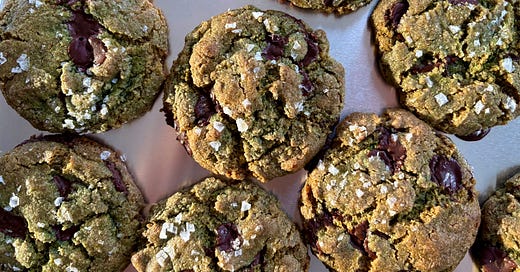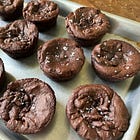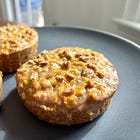First let’s address the green. Early in my sunflower baking journey, I mixed some seeds into muffin batter. A day after baking them, I broke one open and saw bits of green inside — how could they already be moldy!? Luckily, I didn’t throw them out, but learned that a compound CGA (chlorogenic acid, which has antioxidant and anti-inflammatory properties) present in sunflower seeds reacts with alkaline baking soda and causes the green color. Since then, I’ve witnessed cookie dough made with sunflower seed butter slowly turn green as it cures in the fridge, and seen sunflower baked goods dye other foods green just by being packed close together. I’ve learned to embrace it, though it weirds out some customers. But why should green baked goods be a once-a-year St. Patricks experience made possible by artificial food coloring?
There is so much to love about sunflower seeds. They’re high in micronutrients, especially Vitamin A, which is great for the immune system, vision, skin, and hair. They’re less allergenic than peanuts or tree nuts. As I detailed in my last post, they have a smaller ecological footprint than certain nuts and help clean up the soil. And their versatility in the kitchen is immense — they can be used like nut butter or tahini, soaked and ground like cashews, in flour form like almond flour, or as a crunchy mix-in or garnish. Though their flavor is specific, it’s less evocative than peanut or almond butter and I think spans the sweet-savory divide better. And they’re cheap (relative to nuts) even if you choose organic.
I still have a long list of sunflower experiments I’ve been meaning to get to (sunflower mousse, sunflower buttercream, sunflower halvah, sunflower praline), but if I tried to complete all of them this post would never come out. So I’ll share what I’ve learned so far: a little bit of botany/chemistry, some history, information about how I use sunflower products, and a few mini-recipes or inspiration points for you to incorporate them into your kitchen. As always, I would love to learn from you! Please drop a comment if there are any ways you use sunflowers, or if there’s anything you want me to try to do with them.
The Science: Look inside a sunflower seed
Trying to break down the botanical differentiation between nuts and seeds quickly starts to get stupid. “Seed” is a wide category that encompasses “nuts,” but most of the things that we call nuts are not technically nuts — peanuts are of course legumes, but cashews and almonds are “drupes” (in the same family as peaches and apricots — maybe you’ve heard someone say that an almond is just an apricot pit) and walnuts and pecans are kinda suspect drupes. Chestnuts, acorns, and hazelnuts are definitely nuts. Sunflower seeds are called “achenes,” which is a different kind of dry fruit.
A sunflower seed has a hard starchy hull/shell that surrounds the buttery protein-rich kernel. The hull is high in lignin, which is indigestible, so you can’t eat a ton of it. Sunflower seeds are sold de-hulled or with the hull (like those David’s bags you see at gas stations — people typically crack them in their mouths and spit out the shells). Sunflower butter is made from roasted kernels; sunflower oil is made by pressing whole seeds (and sometimes adding chemical solvents); sunflower flour is a somewhat rare product that’s made from the mash left over from pressing seeds for oil.
In baking, sunflower products are a great non-animal source of fat (which I wrote about at length in my “Nuts Are My Butter” piece). They’re also naturally high in lecithin, which is so powerful as a stabilizer and emulsifier that it’s often extracted and used as an additive. This means that they can help play some of the role that eggs do in conventional baked goods. I use all kinds of sunflower products in my baking for these binding properties and to add richness to things like brownies and a tender crumb to things like cake.
The History
As I mentioned in my last post, sunflowers were cultivated and eaten by the Lenape people of this region, but they weren’t a staple food. Justin Wexler of Wild Hudson Valley described the typical process for me: whole heads were dried on a rooftop, then the seeds were removed and roasted on the coals of a fire, then pounded into a paste. The paste could be added to soup or mixed with corn for bread, or simmered into “a sunflower milk/coffee — I can attest that it's delicious.” (He says you could try it yourself by grinding whole roasted seeds and using them in a machine like coffee grounds.) As the mixture cooled, oil would congeal on top, which could then be skimmed off and used for cooking, cosmetic, and ceremonial purposes.
The Spanish brought sunflowers back to Europe, where they were grown as ornamentals. In the 1700s, Peter the Great brought them to Russia for oil production. The Russian Orthodox Church inadvertently encouraged the cultivation of sunflower oil by banning the use of other oils during Lent (what is it with authoritarianism and banning oils?). Sunflowers were grown at scale throughout Russia and Ukraine, and the new cultivated varieties also made their way back to North America. They continued to be grown primarily for oil, but with peanut and tree nut allergies on the rise in the early 2000s, the USDA and food companies began to take more of an interest in sunflower products as an allergy-friendly food source. From SunButter to these sunflower seed-butter cups from Trader Joe’s, I feel like l’m seeing sunflower seeds in all kinds of packaged goods these days.
Using sunflowers
Sunflower seeds
It’s easy to toss whole seeds into muffins or bread, and that’s a great place to start. Roasting brings out their flavor and makes them more crunchy, so I’ll typically roast them (300°F, 20 minutes) if I want the flavor or leave them raw for something more neutral. Roasted seeds make a great pesto or sandwich spread like the one below.
Soaking raw seeds overnight (in the fridge), then straining and grinding is an excellent technique for adding sunflower seeds to batter. You’ll see similar techniques in all kinds of vegan recipes, but usually with cashews — just substitute sunflower seeds instead. The mixture is also similar to tahini, so you can play around with swapping it in any tahini-based recipes (though the flavor will be different). This technique is a cheaper alternative to incorporating a pre-made nut butter, but by soaking you’re adding additional water, so the flavor is diluted. I use soaked sunflower seeds in my recipe for rich chocolate brownies (I make these every week to sell at the High Falls Food Co-op and just updated my recipe here!)
Sunflower butter
Sunflower butter is just ground roasted sunflower kernels. (New York State actually requires the seeds to be roasted, as I learned from Eva Rodriguez, the maker of my favorite sunflower seed butter Redhook Dreams.) Most sunflower seed butters I’ve seen on supermarket shelves contain added sugar, so keep an eye out for that and adjust your recipes accordingly.
I add sunflower butter to cookie and cake batters and to my sourdough granola bar mix. The effect is similar to the soak-and-grind method above, but the flavor is stronger when using the butter and the binding power is more effective because there isn’t any added water. This carrot cake recipe is a good example of using sunflower butter in cake batter, where it adds that richness you want in a carrot cake without making it excessively oily.
Sunflower flour
I get my beautiful buckwheat-gray sunflower flour from Hudson Valley Cold-Pressed Oils. The flour is made as a byproduct of pressing sunflower oil — most of the shell get sifted out, but it’s still enough to make the flour very dark. It’s a starchy, somewhat powdery flour that still contains about 60-65% of the fat (this is due to HVCPO’s gentle extraction method — chemical extraction would take 90% of the fat, leaving a mash that’s almost all starch). I tend to treat it like almond flour, though it has a slight bitterness and the starchiness means it doesn’t work perfectly as a 1:1 substitution. I like to add just a little bit to my batters — while I haven’t found it to work too well in 100% applications, at around 30% it’s a good way of adding fat to yield a tender crumb in cakes or brownies, as well as a hint of sunflower flavor.
I use it in these sunflower juniper cakes and sunflower apple walnut bagel bars, and I’ve incorporated it into the brownies above.
Sunflower oil
Sunflower oil is typically considered a neutral oil by chefs and in most recipes — but that’s because most oil is extracted at high heat and with chemical solvents so that it ends up flavorless. I still use this kind of oil in some recipes, but I’ve enjoyed playing around with Hudson Valley Cold-Pressed Oil and want to try out another cold-pressed local oil, Fonte Puro, that I learned about recently. Though I primarily use it as a finishing oil — in a fresh summery salad or drizzled on roasted vegetables — it can substitute well for olive oil in any recipe that can take a little sunflower flavor, like these porridge muffins.
Some mini recipes for you to add sunflowers to your kitchen
Warming sunflower drink
On a rainy day the other week, I ordered the tahini meltaway drink at Lagusta’s Cafe. It’s based on their tahini meltaway chocolates and actually made from them as well — scraps are blended up with fudge sauce and added to warm drinks. It’s the perfect thing when you want a treat drink, but aren’t in the mood for a whole hot chocolate.
I started making a super simple version at home using sunflower seed butter — for an 8oz cup of hot milk (I use soy milk), I mix in 1 tablespoon sunflower seed butter, 1 teaspoon maple syrup, and a pinch of salt.
Candied sunflower seeds
These are so easy and really phenomenal as a crunchy topping for whatever — oatmeal or ice cream — or just as a snack or mixed into a trail mix or granola. In a skillet, combine ⅓ cup sunflower seeds with 2 tablespoons brown sugar and a pinch of salt, and stir until the sugar has melted and coats the seeds. Remove to a sheet pan and let cool.
Savory sunflower paste or cream
This was the base of an oyster mushroom-fiddlehead fern galette I made on Monday — to my Vitamix, I added about ¾ cup raw sunflower seeds, 2 tablespoons toasted sesame seeds, ½ cup vegan yogurt, a couple tablespoons nutritional yeast, and a little salt and pepper. I blended it into a chunky paste and spread it on some puff pastry before layering on the vegetables.
Or you could make a smoother cream, the way my friend (and brilliant chef) Alexis Sicklick did. In a blender, combine 3 tablespoons extra virgin olive oil,1 caramelized yellow onion, ½ cup raw sunflower seeds, ½ cup water, the juice of 1 lemon, 1 tablespoon nutritional yeast, and 1 teaspoon salt. Blend until smooth. (This cream is part of her upcoming dinner with Accordion Wines — tickets still available!)
Posts like this take a long time to put together! If you want to support my work, consider becoming a paid subscriber.
What I’m Cooking
Sesame Scallion Rolls (v)
Hey Hudson Valley, come out Sunday to the Basilica Farm & Flea Festival in Hudson! I’ll be selling a special menu of treats along with other Asian-diaspora vendors curated by Enoki — I'll have black sesame twix with soy sauce caramel, málà peanut butter cookies, brownies with Chinese sesame paste swirl, shiitake chocolate cookies, and sesame scallion ro…









I started reading this and said to myself, Wow, someone else was just telling me about sunflowers being native…. took me a minute! 😆